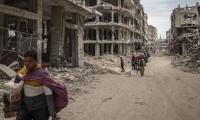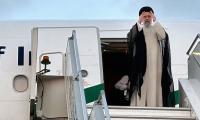The Baloch problem has so far mostly been seen from the lens of the classic realist angle of national security. The pathologies identified and the remedies suggested for resolution of the crisis also therefore bear a strong imprimatur of a security-centred approach.
It is time the simmering discontent was doused with a human security centric approach appealing directly to the public weal of a disenfranchised and disempowered population suffering from a ‘dejure-defacto’ paradox of a weakly governed province.
The de-jure reality of Balochistan features an electoral process and the representative institutions that promise inclusiveness and plurality but the reality is different. The low voter turnout in the Makran belt and the captive voters paying obeisance to entrenched tribal hierarchy elsewhere reflect the de-facto reality where the tyranny of geography combines with the apathy of the leadership at the expense of the hapless populace.
Why Baloch issues have not been addressed as per a human-centric paradigm should be an interesting question to begin a debate on the causes, consequences and remedies of the conflict. Our policy planners and security analysts associated with the policy prescriptions in the province have for far too long wrestled with the political dimensions of the issue, to the exclusion of a socio-economic strategy that could have ameliorated the lot of the common people.
There has little focus on human security while framing the parameters of the security debate on the Baloch conflict in the past. The human security concept that espouses the safety of humans from myriad threats like hunger, disease, violence, poverty and joblessness runs against the grain of our accumulated security wisdom weaned on the classic security precepts defined by scholars like Barry Buzan, who amongst their trinity of security referents – individuals, state and the international system – privilege the state over all others.
What badly needs to be understood is that state security is a consequence, and not the cause of human security. Social constructivists like Danish Professor Ole Waever have tried to challenge the above state-centric concept of security by presenting a new concept of human security where poverty, disease, and violence replace the wars and revolutions in the threat matrix of security debate.
If we carefully analyse the history of Baloch discontent that found violent expression in 1948, 1962-63 1973-77, and 2003 onwards, a clear pattern of socio-economic deprivation coupled with a strong narrative of resource exploitation is discernible; this was capitalised upon with varying success by different armed uprisings. Countering all past uprisings with the kinetic instrument the underlying causes of the discontent have not been addressed by the state of Pakistan.
Sustainable peace through solid state building requires a very high degree of statesmanship as well as empathy with public grievances. In a very perceptive commentary, ‘An Agenda for State Building in the Twenty First Century’, by Ashraf Ghani et all, the authors point out the need for removing the root causes of the conflict, as well as for investment in human security without which post-conflict stability will invariably relapse into instability. As per social scientists Collier and Hoeffler, the interplay of four variables – per capita income, natural resource endowment, inequality, and ethno linguistic fragmentation – magnifies the chances of a civil war.
With income per capita as low as $400, 52 percent of households living below the poverty line, unresolved feelings of provincial resource exploitation and ethno-linguistic fragmentations like Baloch-Punjabi, and Pakhtun-Baloch, the province’s witches’ brew of grievances presents propitious conditions for an intractable conflict.
The provincial political scene presents a structural malaise with the usual political jockeying for key appointments while a vast swathe of politically conscious population in the Makran belt are effectively under the thrall of ethnic particularists. What are the reasons of public disenchantment with the government? Why is the separatist narrative, though externally abetted, still holding public imagination?
The answer to the above questions lies in the seven elements of human security – physical, food, health, community, political, environment, and economic security. Economic security’s most important dimension is job creation which is directly linked with poverty. According to a World Bank sponsored Balochistan Economic Report the province needs 158,000 jobs and a growth rate of 6.5 percent annually to lift a significant percentage of the poverty-affected population above the poverty line.
The demographic realities of a fast increasing, yet young, population present job creation challenges to a government that relies more on politics of patronage than merit or equity. Poor utilisation of large disbursements by the federal government for poverty alleviation and development has exacerbated the socio-economic inequalities in the province. With large development funds gobbled up by a hungry political and administrative machinery, the people are left at the mercy of fate and a tyrannical geography. Due to large distances and poor communication network the scattered population finds it difficult to integrate with the mainstream of the provincial economy.
The uncertain security situation has significantly diminished the prospects of foreign investment and resource exploration of a mineral and energy rich province. There is no doubt that due to the remoteness of locations and low population the cost of service delivery is very high in Balochistan but the will to deliver is also woefully lacking. With a bloated and poorly skilled bureaucracy having the largest sanctioned strength of officials compared to all provinces overseen by a political leadership concerned more with their perks and privileges the odds are heavily stacked against the common people.
Balochistan requires significant resource allocation for bringing meaningful changes in living standards due to its vast geography and dispersed population. A disproportionate investment in terms of infrastructural development is required compared to other high-density compact provinces like Punjab and Sindh to make any impact on the socio-economic life of people.
When translated into electoral gains, the recompense for the development initiatives of the political leadership is minimal in Balochistan as compared to other provinces. This has been the tragedy of this geographically largest province so far. Socially segmented, politically excluded, and economically marginalised, the new Baloch generation has risen up in revolt.
Small wonder then that the effect of the non-Sardar led armed uprising is the greatest in the Makran belt known for its relatively high literacy rate and political consciousness. But amidst all this doom and gloom a silver lining illumines the path towards progress. That silver lining is the China-Pakistan Economic Corridor, which if properly handled can act as a game changer for Balochistan.
Here is a chance for a government whose development initiatives in Balochistan were hamstrung by lack of political dividends to synergise the province’s infrastructural development with the CPEC in order to improve the connectivity of this province with the lowest road length per kilometre in the country.
The infrastructural development should be coordinated with job creation and improved access to public goods like safe drinking water, health, and education. Political reforms to break the stranglehold of Sardars and clans are also needed for wooing back the estranged sub-nationalists of the BLF in the Makran belt.
People-centred equitable development and inclusive polity is therefore the scarlet thread that would bind state and human security into a symbiotic relationship for the survival and prosperity of the federation as well as Balochistan.
The writer is a retired brigadier, and a PhD scholar in Peace and Conflict Studies at the National University of Science and Technology, Islamabad.
A health worker administers polio vaccine drops to a child during a door-to-door polio vaccination campaign in Lahore,...
Armed militants of the banned Tehreek-e-Taliban Pakistan pose for a photograph in Orakzai Agency. —...
An aeroplane of the national flag carrier of Pakistan is seen in this file photo. — AFPWhile Pakistan considers...
Representational image of a graph depicting various variables. — APP/FileInitiated by the centre and fiercely...
In this picture taken on April 16, 2023, people throng a market area during shopping in Lahore. — AFPOne of the...
Honour crimes also target men. In Sikandar Ali Lashari vs The State, SHC upheld conviction passed by ATC for honour...







